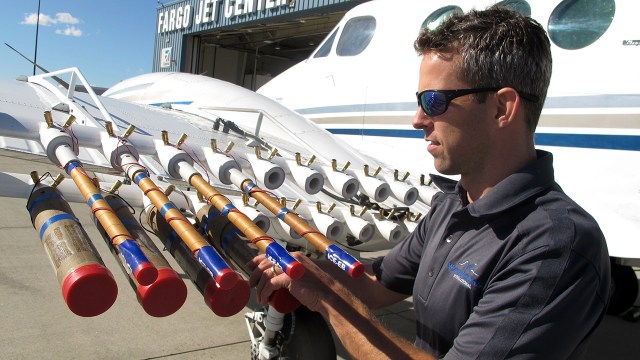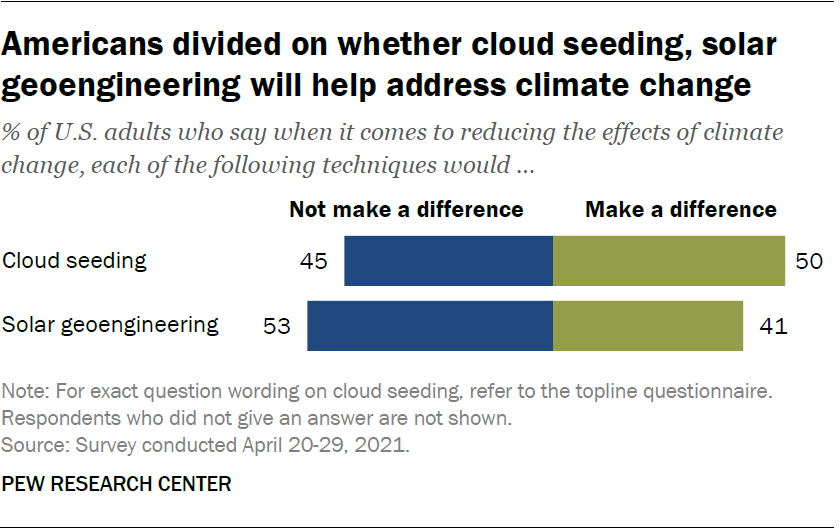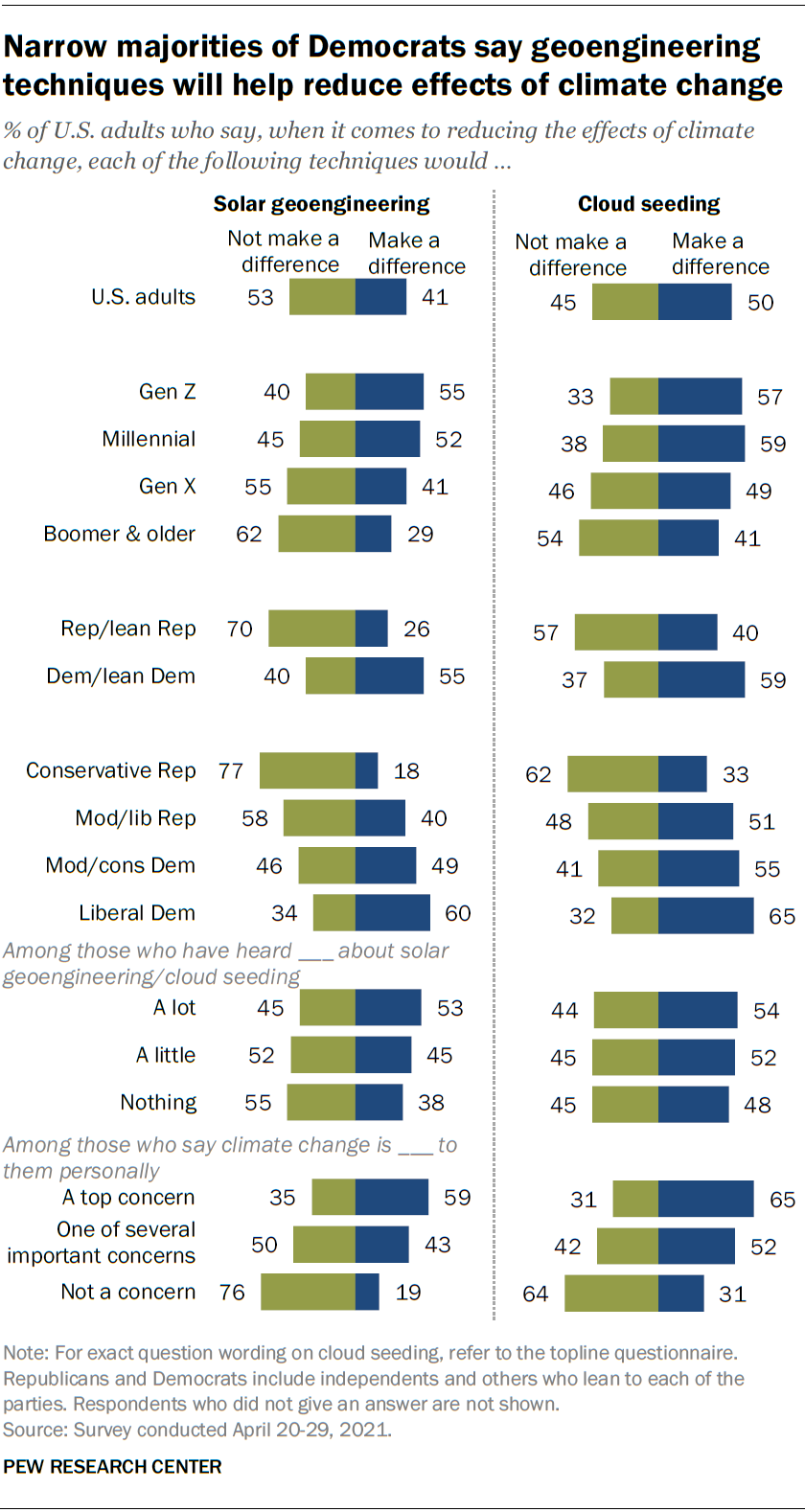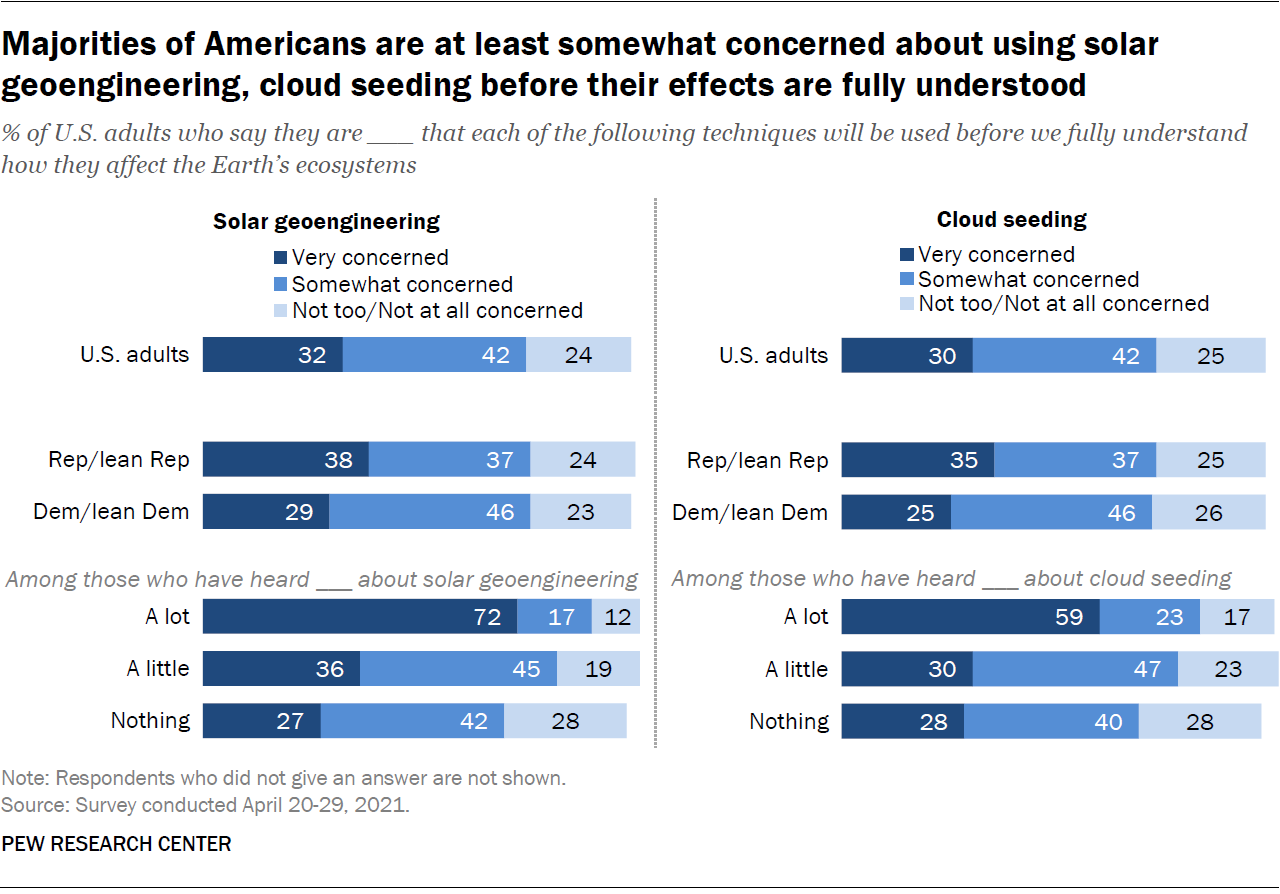

No more than half of U.S. adults say they think two geoengineering techniques – solar geoengineering and cloud seeding – would make a difference in reducing the effects of climate change, and most are worried about unintended consequences from these approaches, according to a recent Pew Research Center survey.

Scientists and policymakers are exploring the use of several geoengineering techniques to alter the environment in ways that could reduce the effects of climate change. Solar geoengineering is a proposed technique that aims to temporarily lower Earth’s temperature by spreading particles in the atmosphere to reflect sunlight back into space. A recent report from the National Academies of Sciences, Engineering and Medicine recommended that the U.S. federal government invest up to $200 million in researching the effects and feasibility of solar geoengineering.
How we did thisPew Research Center conducted this study to understand how Americans view climate, energy and environmental issues – in this case, their views of geoengineering techniques. We surveyed 13,749 U.S. adults from April 20 to 29, 2021.
The survey was conducted on the Center’s American Trends Panel (ATP) and included an oversample of adults ages 18 to 24 from the Ipsos Knowledge Panel. A total of 912 Generation Z adults, born after 1996, were included in the sample.
Respondents on both panels are recruited through national, random sampling of residential addresses. This way nearly all U.S. adults have a chance of selection. The survey is weighted to be representative of the U.S. adult population by gender, race, ethnicity, partisan affiliation, education and other categories. Read more about the ATP’s methodology.
Here are the questions used for this report, along with responses, and its methodology.
Cloud seeding, another form of geoengineering, involves dispersing particles in the atmosphere to encourage rain and snowfall. At least eight Western states have recently used this technique in an effort to increase precipitation and the water supply for rivers and lakes.
About four-in-ten Americans (41%) say they think solar geoengineering technology would make a difference in reducing the effects of global climate change, while 53% say it would not make a difference. Opinion about the effectiveness of solar geoengineering is roughly the same as when the question was last asked in 2018, when 45% of adults said it would make a difference and 53% said it would not.
The idea of solar geoengineering is familiar to only a small share of the public: Just 4% say they have heard or read a lot about this, another 38% say they have heard a little and a majority (57%) have heard nothing at all.
Americans are also divided over whether cloud seeding would help in reducing the effects of climate change-related drought. Half of adults say it would make a difference, while 45% say it would not.
 effects of climate change" width="840" height="1578" />
effects of climate change" width="840" height="1578" />
Again, the public is largely unaware of this technique: 53% of Americans say they’ve heard nothing about cloud seeding, another 42% say they’ve heard a little about it and just 4% have heard a lot.
Democrats and Democratic-leaning independents, especially those who self-identify as liberal, are more optimistic than Republicans and GOP leaners about geoengineering’s potential impact. For instance, a majority of liberal Democrats (60%) say they think solar geoengineering would make a difference in reducing the impact of climate change, compared with just 18% of conservative Republicans.
People who say addressing climate change is a top concern to them personally are also more optimistic about the potential impact of these technologies: Majorities of these adults say solar geoengineering (59%) and cloud seeding (65%) would make a difference in reducing the effects of climate change.
Younger adults – who are more likely to identify as Democrats and as ideologically liberal, and to say addressing climate change is a top personal concern – are more positive about geoengineering. For example, more than half of Gen Z or Millennial adults (55% and 52%, respectively) say they think solar geoengineering techniques would make a difference in reducing climate change’s effects, compared with 29% of Baby Boomer and older adults.

Some researchers have expressed concern about geoengineering and argued that the technology could have unforeseen negative impacts on the Earth’s climate. Earlier this year, climate researchers halted a test of solar geoengineering technology in Sweden after environmental conservationists and indigenous groups objected.
Large majorities of Americans worry that both technologies will be deployed before scientists fully understand the environmental consequences of using them. More than seven-in-ten U.S. adults say they are very or somewhat concerned that solar geoengineering (74%) or cloud seeding (72%) will be used before we fully understand how they affect the Earth’s ecosystems. That includes about a third who say they are very concerned about this (32% and 30%, respectively).
People who have heard a lot about these technologies are especially likely to express concern. For example, 72% of adults who have heard a lot about solar geoengineering say they are very concerned it will be used before we understand how it impacts Earth’s ecosystems, compared with 36% of those who have heard only a little about it and 27% who have heard nothing. A similar pattern occurs with views about cloud seeding: A majority of those who have heard a lot about it (59%) say they are very worried about using such techniques before we understand their effects, compared with about three-in-ten of those who have heard a little or nothing about it.
Note: Here are the questions used for this report, along with responses, and its methodology.